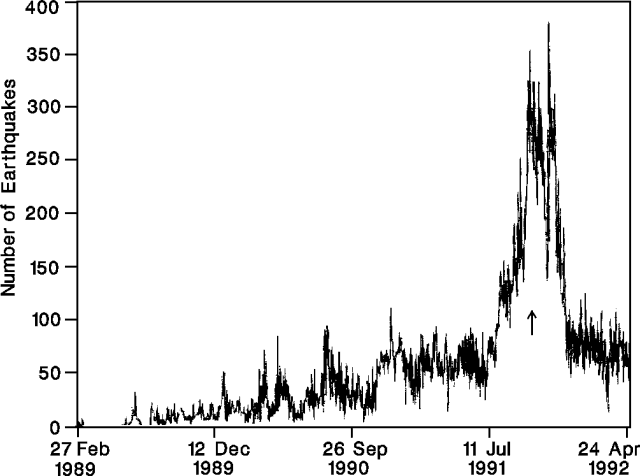Report on Galeras (Colombia) — April 1992
Bulletin of the Global Volcanism Network, vol. 17, no. 4 (April 1992)
Managing Editor: Lindsay McClelland.
Galeras (Colombia) Gas and ash emissions; audible explosions; tremor and bursts of earthquakes
Please cite this report as:
Global Volcanism Program, 1992. Report on Galeras (Colombia) (McClelland, L., ed.). Bulletin of the Global Volcanism Network, 17:4. Smithsonian Institution. https://doi.org/10.5479/si.GVP.BGVN199204-351080
Galeras
Colombia
1.22°N, 77.37°W; summit elev. 4276 m
All times are local (unless otherwise noted)
Gas and ash were emitted daily in April, accompanied by strong sulfurous odors, with some explosions audible to 500 m away. Activity was concentrated in the W part of the crater and 1991 dome, along a fracture to the NW, and in Portillas crater. Sulfur deposits were visible around gas vents at the extreme SE and S margins of the dome, where explosive activity was minor.
Long-period seismicity in April was similar to the previous several months (figure 53), although a slight increase in amplitude, released energy, and number of events was noted. The majority of the signals arrived in groups, and tended to occur at certain hours of the day. Tremor, generally spasmodic in character, remained at low levels, but at higher amplitudes than previous months. Eleven high-frequency earthquakes (M 1.1-2.5) were recorded in April, centered principally in the W part of the summit crater. Electronic tiltmeter measurements indicated little deformation since early 1992, with only minor amounts of deflation recorded [at Crater Station].
 |
Figure 53. Daily number of long-period earthquakes at Galeras, 27 February 1989-24 April 1992. An arrow marks the first observation of the lava dome, on 9 October 1991. Courtesy of INGEOMINAS. |
Geological Summary. Galeras, a stratovolcano with a large breached caldera located immediately west of the city of Pasto, is one of Colombia's most frequently active volcanoes. The dominantly andesitic complex has been active for more than 1 million years, and two major caldera collapse eruptions took place during the late Pleistocene. Long-term extensive hydrothermal alteration has contributed to large-scale edifice collapse on at least three occasions, producing debris avalanches that swept to the west and left a large open caldera inside which the modern cone has been constructed. Major explosive eruptions since the mid-Holocene have produced widespread tephra deposits and pyroclastic flows that swept all but the southern flanks. A central cone slightly lower than the caldera rim has been the site of numerous small-to-moderate eruptions since the time of the Spanish conquistadors.
Information Contacts: J. Romero, INGEOMINAS-Observatorio Vulcanológico del Sur.

